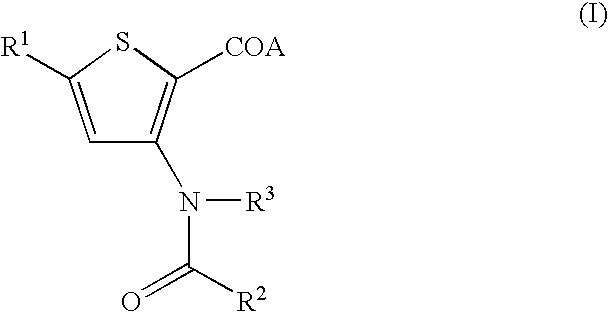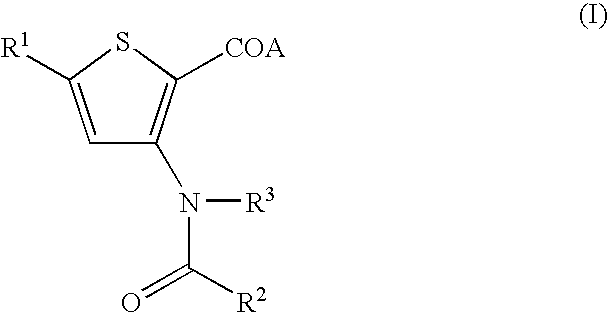Antiviral 2-Carboxy-Thiophene Compounds
a technology of thiophene derivatives and carboxythiophene, which is applied in the field of antiviral 2-carboxythiophene derivatives, can solve the problems of hcv genotype, inability to develop a vaccine in the near future, and inability to meet the needs of antiviral agents
- Summary
- Abstract
- Description
- Claims
- Application Information
AI Technical Summary
Problems solved by technology
Method used
Image
Examples
example 1
5-(4-Furo[3,2-b]pyridin-2-ylphenyl)-3-[[(trans-4-methylcyclohexyl)carbonyl](1-methylethyl)amino]-2-thiophenecarboxylic acid
[0859]
[0860]Intermediate 8 (35 mg) and sodium hydroxide solution (2M, 0.2 mL) in THF (0.2 mL) and MeOH (0.2 mL) were stirred at room temperature for 22 h. The mixture was partitioned between 2M HCl (5 mL) and DCM (5 mL). The aqueous fraction was extracted further with DCM (5 mL) and the combined organics evaporated. This was purified by MDAP to give the title compound.
[0861]MS calcd for (C25H30N2O4S+H)+: 503
[0862]MS found (electrospray): (M+H)+=503
[0863]1H NMR (CD3OD): δ8.48 (1H, d), 8.1 (2H, d), 8.01 (1H, d), 7.92 (2H, d), 7.48 (2H, d), 7.38 (1H, m), 2.12 (1H, m), 1.9-1.2 (8H, m), 1.25 (3H, d), 1.05 (3H, d), 0.79 (3H, d), 0.76-0.6 (2H, m), carboxylic acid proton not seen.
example 2
3-[[(trans-4-Methylcyclohexyl)carbonyl](1-methylethyl)amino]-5-(4-pyrazolo[1,5-a]pyrimidin-2-ylphenyl)-2-thiophenecarboxylic acid
[0864]
[0865]Intermediate 11 (94 mg) and sodium hydroxide solution (2M, 0.5 mL) in THF (0.5 mL) and MeOH (0.5 mL) were stirred at room temperature for 24 h. The mixture was evaporated and partitioned between 2M HCl (10 mL) and DCM (10 mL). The aqueous was extracted further with DCM (10 mL) and the combined organics evaporated. This was purified by SPE chromatography, eluting with cyclohexane to cyclohexane / EtOAc (2:1) to (1:1) to (1:2) to EtOAc; EtOAc / MeCN (1:1), MeCN, MeCN / acetone (1:1) to acetone to acetone / MeOH (1:1) to MeOH. This was purified further using MDAP and freeze dried from dioxane. Further purification using an NH2 ion exchange SPE cartridge gave the title compound.
[0866]MS calcd for (C28H30N4O3S+H)+: 503
[0867]MS found (electrospray): (M+H)+=503
[0868]1H NMR (CD3OD): δ 8.94 (1H, d), 8.51 (1H, dd), 8.14 (2H, d), 7.88 (2H, d), 7.46 (1H, s), 7.12 ...
example 3
5-(4-Imidazo[1,2-a]pyridin-2-ylphenyl)-3-[[(trans-4-methylcyclohexyl)carbonyl](1-methylethyl)amino]-2-thiophenecarboxylic acid
[0874]
[0875]Intermediate 13 (36 mg) and sodium hydroxide solution (2M, 0.2 mL) in THF (0.2 mL) and MeOH (0.2 mL) were stirred at room temperature for 4 h. The mixture was evaporated and then partitioned between 2M HCl (5 mL) and DCM (5 mL). A solid formed in the aqueous phase which was collected, dissolved in methanol and co-evaporated with diethyl ether. Freeze-drying from dioxane gave the title compound.
[0876]MS calcd for (C29H31N3O3S+H)+: 502
[0877]MS found (electrospray): (M+H)+=502
[0878]1H NMR (CD3OD): δ 8.81 (1H, d), 8.66 (1H, s), 8.05-7.9 (6H, m), 7.6-7.48 (2H, m), 2.12 (1H, m), 1.8-1.25 (8H, m), 1.24 (3H, d), 1.0 (3H, d), 0.79 (3H, d), 0.76-0.6 (2H, m), carboxylic acid proton not seen.
PUM
| Property | Measurement | Unit |
|---|---|---|
| temperature | aaaaa | aaaaa |
| temperature | aaaaa | aaaaa |
| temperature | aaaaa | aaaaa |
Abstract
Description
Claims
Application Information
 Login to View More
Login to View More - R&D
- Intellectual Property
- Life Sciences
- Materials
- Tech Scout
- Unparalleled Data Quality
- Higher Quality Content
- 60% Fewer Hallucinations
Browse by: Latest US Patents, China's latest patents, Technical Efficacy Thesaurus, Application Domain, Technology Topic, Popular Technical Reports.
© 2025 PatSnap. All rights reserved.Legal|Privacy policy|Modern Slavery Act Transparency Statement|Sitemap|About US| Contact US: help@patsnap.com



